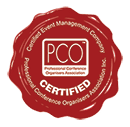With the large numbers of people now working from home and practising social distancing – online learning, meeting and collaboration platform use is at a peak. But with so many options to choose from you may be wondering what is what when it comes to online events?
Our team has compiled a brief summary of the different ways of engaging with an audience online, to help you decipher which format of delivery is best for your organisation.
- Live streaming
Here sessions are available for live viewing via an online digital platform, like a live broadcast.
Pros
The content is available to anyone with an internet connection, anywhere in the world and presenters don’t have to pre-record any material so it can feel more like a real face to face connection. This also allows for questions and comments to be answered live if you choose to do so.
Cons
There are a lot of risks that are outside of your control, including presenters having issues with technology, presenters not attending or unexpected interruptions or curveball questions. We’ve all experienced those awkward moments when people are live streaming and don’t realise that they’re live yet, or get interrupted by something non-related at home or in the office!
- Recorded
This is when all presentations are pre-recorded and released on the day of the event as per a pre-set and released program or agenda.
Pros
You have more control over the technology here so there is less risk of technology issues and speakers/presenters have the opportunity to fine-tune and edit content.
Cons
There’s more work involved with presentations needing to be edited, pre-loaded and compiled and the interaction/engagement opportunities are limited during the actual presentation, so you need to work much harder to keep your audience engaged.
- Recorded, but with live interaction
In this format, the speakers are present during the session to run Q&A following (or during) their pre-recorded presentation.
Pros
This type of event creates a balance of live and recorded formats so that presenters can focus on interaction and increasing participation and interest in the session.
Cons
More work is involved with presentations needing to be pre-loaded and you need to be careful about how this process is managed when live. For example, if 200 questions are asked within a 15 minute period it will be difficult to answer and filter through in a way that ensures all participants feel heard and involved.
- Hybrid
This type of presentation involves a traditional face-to-face event held at a physical venue, with sessions also streamed digitally, allowing for live virtual attendance.
Pros
You may be able to secure additional revenue from virtual delegates who would not normally have attended in person (ie they might be located in a remote location and cannot travel due to restrictions). This also allows speakers to present remotely.
Cons
There are additional costs involved in recording live presentations and the risk of technology not working needs to be carefully planned for.
- On-demand streaming post-event
Where all presentations (live and pre-recorded) are made available via an online digital platform for on-demand viewing post-event.
Pros
You can create and re-use valuable content by recording sessions, which offers an additional revenue opportunity and increased sponsorship opportunities.
Cons
Additional costs and time involved in recording live presentations and making all sessions available to stream via an online digital platform.
Still not sure? Don’t hesitate to reach out to Expert Events for advice on the best way to present your information by hosting a virtual or hybrid event.






